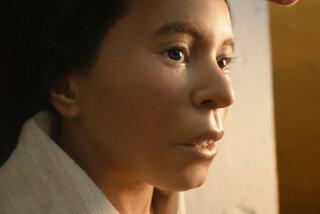Lady X Comes to L.A. to Unravel the Riddles of Mummy Decay
- Share via
Lady X may have been a commoner when she was born about three millennia ago, but no one can say for sure. Her importance, however, far transcends her ancient Egyptian roots and could affect how museums worldwide preserve mankind’s culture.
Lady X--a mummy--arrived Sunday night at Los Angeles International Airport aboard a passenger jet from Cairo.
She was transported in a simple pine, coffin-like box to a laboratory at the Getty Conservation Institute in Marina del Rey.
Today, under the scrutiny of Customs agents, the box will be gently pried open.
The point of the complex exercise, institute director Luis Monreal told a news conference Monday, is to conduct a series of largely temperature-oriented experiments aimed at determining optimum conditions for preserving aging, organic materials, such as mummies.
“We will design a very special artificial environment that will help in arresting the decay process,” said Monreal, whose institute is becoming a leading center for the scientific preservation and restoration of artworks.
The mystery woman, Monreal and other Getty and Egyptian officials told reporters, has brown skin, wavy yellowish-brown hair, is about 4 feet, 10 inches tall and, largely because of dehydration over thousands of years, weighs little more than 19 pounds.
“This mummy was not chosen because of her beauty,” Monreal said.
Instead, he said, Lady X is purely an object of research. Data generated by six months of experiments at the institute--part of the J. Paul Getty Trust, which also operates the J. Paul Getty Museum in Malibu--was expected to provide more efficient preservation techniques for Egypt’s revered 27 royal mummies, of which 15 are scheduled to go on public display in that country next month for the first time since 1980.
Also, Monreal said, any preservation knowledge would be shared with other museums and could be applied to protecting other organic materials from decay, such as parchment.
Slim Body of Knowledge
Remarkably, in this age of dynamic scientific advancements, said Frank Preusser, director of the institute’s science programs, the state of preservation knowledge is slim. As a result, he said, temperature, humidity and other atmospheric elements are “all helping to destroy our cultural heritage.”
Mummies survived in such good shape, Monreal said, because “the environment below ground is much better” in terms of temperature and humidity stability than the elements above ground.
That the Egyptian government is even allowing a mummy to leave the country is a news event. The last time the Cairo government sent a mummy out of the country was in 1976 when the remains of Pharaoh Ramses II--one of the royal 27--were sent to France in an effort to treat fungus that was ravaging the body.
Gradual Erosion
The problem with Ramses, and the belief that the other 26 mummies of great historical significance could face the ruin of time’s gradual erosion, eventually led to the Getty experiment on a mummy of lesser historical value.
Egypt has literally thousands of mummies, mostly commoners, excavated from a number of archeological digs. Lady X, Monreal said, was selected from this mass of human antiquity and accompanied to the United States by Kamal Barakat, director general of the Egyptian Antiquities Organization’s conservation center and Ahmed Abd El Rady, another official with the center.
Getty scientists estimated that Lady X, discovered in the 1960s north of the Egyptian city of Luxor, may have lived between 1050 and 1500 BC, a period in Egyptian history touching on an era called the New Kingdom, which historians have called a renaissance for the Pharaohs in art, power and, the subject at hand, mummification. At that time, even a commoner like Lady X could afford a little status in the form of mummification which preserved her for the ages--and for the Getty experiments.
Humidity Level
One of the major challenges, Getty scientist Steve Weintraub said, will be to place Lady X in a capsule to determine how low a humidity level could be maintained without damaging the mummy. The lower the humidity, the greater the protection from the danger of fungus growth that plagued Ramses, he said. But too low humidity can induce brittleness, he added.
“We want to keep (the mummy) in the condition we found it,” he said. The problem, he said, then becomes, “How can we lower the humidity without altering the state of the mummy?”
Monreal emphasized that Getty scientists would be treating Lady X “with respect” and that, therefore, her remains will not be dissected.
“It’s a scientific specimen,” he said, “but it’s also a human body.”
More to Read
The biggest entertainment stories
Get our big stories about Hollywood, film, television, music, arts, culture and more right in your inbox as soon as they publish.
You may occasionally receive promotional content from the Los Angeles Times.










